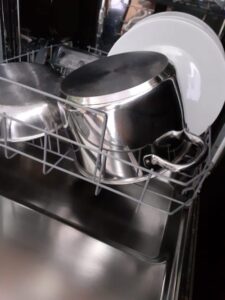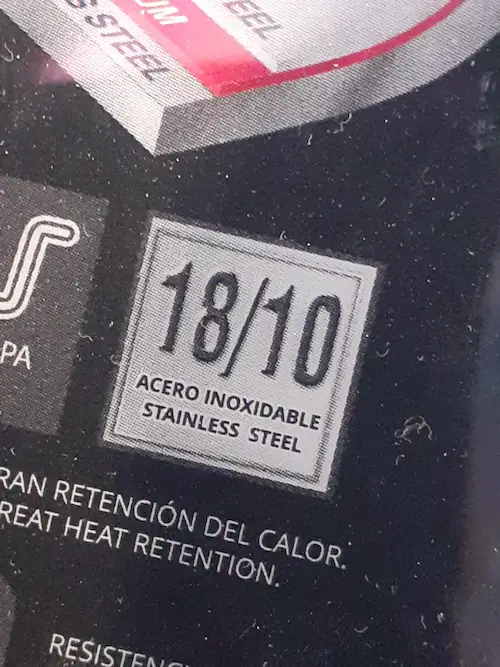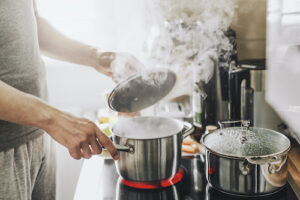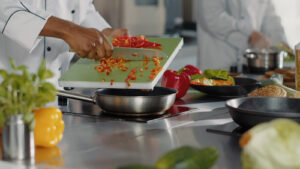This post contains affiliate links. When you buy through our links, we may earn a commission.
Is stainless steel healthy? Yes it is, Let’s discover the many advantages of stainless steel, how to choose quality stainless steel cookware.
For us, consumers, food safety in the use of domestic kitchen equipment is one of our greatest concerns.
One can wonder in particular about the use of metal utensils, especially in pots and pans made of stainless steel.
The diverse range of stainless steel cookware on the market leads to a difference in quality and it is sometimes difficult to categorize them.
- Certified 18/10 stainless steel is ideal for choosing your cookware.
- Cooking with stainless steel is not toxic to the body.
- Stainless steel is easy to maintain for better food hygiene.
- The uncoated stainless steel frying pan is durable over time.

Stainless steel, real stainless steel, is certainly one of the healthiest materials for cooking food. Still, it is necessary not to be mistaken about the different qualities available!
Let’s discover the many advantages of stainless steel, how to choose quality stainless steel cookware, and the precautions during use, to protect against potential dangers to our health.
5 criteria to recognize good stainless steel
Locating stainless steel by its color

You can easily identify a copper saucepan by its orange color or a cast iron pan by its matte black color or weight. However, stainless steel cookware cannot just be defined by its color due to other pots and pans that come in the same silvery shine.
Stainless steel has a silver metallic color with a more or less shiny shade depending on its finish, but it can very well be confused with other steel materials such as iron or aluminum.
The color of the material is the first sign to know if it is stainless steel but that is not enough.
It is also advisable to avoid aluminum utensils which can easily look like stainless steel.
Aluminum is a very light alloy, made from alumina. It is appreciated by manufacturers because it is inexpensive to manufacture.
However, this component, in high doses, is neurotoxic to the body.
Differentiating between types of stainless steel

There are different varieties of stainless steel depending on the chemical composition because stainless steel is made of an alloy of different metals.
The choice of metals and the quantity used in the manufacture of a stainless steel pan will define the quality of its entire build.
Basically, stainless steel is made up of iron and carbon, which together are called steel.
If we add chromium, a component that has the property of being anti-corrosive to this base, we then obtain stainless steel.
STAINLESS STEEL = IRON + CARBON + CHROME
Any other additional component that can be added to this stainless steel alloy will provide extended properties depending on the use of the product.
If it is not stainless steel, the pan will be made of steel, i.e. iron and carbon. You should know that steel is oxidizable in contact with air humidity or water, unlike stainless steel.
If you invest in a steel pan, your utensil will rust over time.
Rust is not directly toxic at low doses; however, the utensil is not hygienic for preparing your food in complete safety.
Any proliferation of bacteria likely to become impregnated in the micro-cracks should be avoided.
This is why it is essential to choose a stainless steel skillet or Dutch oven when adding to your kitchen collection.
Choose certified food grade stainless steel

Stainless steel, which constitutes the alloy formula with chromium, is generally used to manufacture food-grade stainless steel utensils.
Thanks to the chrome component, it naturally forms a protective layer like a varnish that will protect the utensil from rust.
In stores, you can easily identify the stainless steel with the help of 3 “18/10”, “18/8”, or 18/0” logos.
| 18/10 stainless steel | contains 18% chromium and 10% nickel | The composition is ideal for making frying pans, pots, and pans. Nickel provides better heat resistance |
| 18/ 8 stainless steel | contains 18% chromium and 8% nickel | The composition is more suitable for kitchen knives, for example, the lower amount of nickel results in a softer material, so the knife can be sharpened more easily. |
| 18/0 stainless steel | does not contain nickel | It is used for cutlery that is not naturally subject to high heat. Some people may be allergic to nickel. In order to avoid the risk of allergies, the logo should be checked before purchasing. |
Opting for quality stainless steel
There are different price ranges for stainless steel on the market. They generally correspond to the quality of the product and the type of material used.

The higher the quality of the material, the more it will be made up of alloys of noble materials such as nickel, but also mobydbène, copper, or titanium which will improve the chemical composition of the stainless steel.
Tungsten will be an ideal material for stainless steel utensils compatible with all fires, including the oven because it has the property of improving resistance to high temperatures.
Cooking with induction stainless steel, an indicator of quality

Stainless steel, compatible with induction hobs, is generally more qualitative, and you will be sure to invest in good equipment should you buy them.
To operate pans on an induction hob, they must be equipped with a magnetic bottom.
This thick bottom is generally made of stainless steel which has one or more enclosed layers of aluminum to make the utensil magnetic.
Rest assured, aluminum is not in direct contact with food, so there is no risk of toxicity.
What are the risks of bad stainless steel?

- If the stainless steel is not 100% stainless steel then it rusts. Rust, the result of the oxidation of iron, is not suitable for good hygiene in the kitchen.
- Your utensil turns out not to be stainless steel but aluminum. In this case, aluminum, in high doses, is toxic to health.
- Stainless steel, which is not of good quality, can affect the cooking of food.
The advantages of cooking with stainless steel

Steel is one of the materials mainly used in the kitchen. Its maintenance is easy, but it is also sufficiently robust and resistant to any use. It is used for many reasons:
- Its resistance to corrosion for better food hygiene.
- Its resistance to temperature variations which prevents the material from deforming. Food preparation is more even.
- Its neutrality in taste: stainless steel does not modify the taste of food.
- Its ease of maintenance: it offers perfect hygiene.
- Its durability guarantees its reliability.
- Stainless steel requires little fat for healthier cooking.
- It is a recyclable material.
- Most Stainless Steel are dishwasher safe
Our 5 tips for using stainless steel for healthier cooking
The way stainless steel is used can have an impact on health.

- Cooking with stainless steel requires a certain control of stovetop and oven temperatures to suit each recipe.
Be careful! High temperatures can cause your food to burn.
Follow our step-by-step method for searing meat. Once you have the technique, the stainless steel frying pan is easy to use. For a healthy diet, meat cooked in its own juices, and Regular maintenance”font-weight: 400;”>preparing vegetables without overcooking, stainless steel works like a bomb.
- Regular maintenance of your frying pan will facilitate the daily cleaning and hygiene recommendations of your preparations. By removing grease and dirty residue as you go, you prevent food from sticking to the bottom of the pan.
- It is recommended to salt your preparation once the liquid is hot in your container so that the salt or sodium chloride can quickly dissolve. Otherwise, if you pour the salt into cold water, it will settle on the bottom of the pan. Sodium chloride does not mix well with stainless steel because it attacks the surface without being seen by the naked eye. These are micro-cracks that can set in and deteriorate the material over time. However, don’t worry, this has no direct impact on the migration of components that are toxic to your health.
- When you start cooking, gradually heat the pan to a suitable temperature for a few minutes and immediately pour in the oil to avoid thermal shock between the medium and the liquid. Be careful not to raise the temperature too much to prevent the oil from giving off toxic fumes.
- Stainless steel does not require a lot of fat. You can easily cook healthy meals without excessive amounts of fat.
Conclusion: Should you adopt stainless steel to cook food?

Stainless steel is used everywhere in the kitchen. These include cutlery, kitchen knives, salad bowls, oven dishes, pressure cookers, and cookware but also worktops, sinks, household appliances, and in the manufacturing of coffee makers and food processors.
Stainless steel is one of the materials most used by professionals in the catering trade and food industry. This alloy is also found in hospitals and other medical settings.
Stainless steel is the main ally in terms of food safety and hygiene, in particular, for its ease of disinfection and its sterile properties.
The different steel materials such as stainless steel, aluminum, or iron can leave us cold at the sight of their composition and texture.
However, stainless steel, if it is of high quality, goes very well in our contemporary kitchens.
It offers all the advantages of healthy cooking without the risk of contamination. Eating healthy in complete safety also means using your frying pan correctly with simple gestures.
These include choosing the right cooking temperatures and regularly maintaining your equipment. Just a little practice when cooking with stainless steel and it will have no more secrets from you!
Frequently Asked Questions
Can stainless steel rust?
Stainless steel, as its name suggests, does not oxidize, unlike iron. Its alloy composition, including chromium, prevents it from rusting. Do a simple test with water and if your container shows orange traces of rust in the presence of humidity then it is not stainless steel.
Can I use my stainless steel frying pan without adding grease?
Yes, it is quite possible to cook without fat with uncoated stainless steel. It takes a bit of technique and practice to master the temperature setting. However, you can start cooking in stainless steel by rubbing the bottom of the pan with a paper towel soaked in oil to avoid excess fat.
Is my stainless steel frying pan with non-stick coating safe for health?
Coated stainless steel requires more care, especially where the coating is concerned. Be sure to use reasonable cooking temperatures and avoid setting it to maximum heat. Take care of the coating using utensils that do not scratch, preferably a nylon brush for gentle cleaning.
